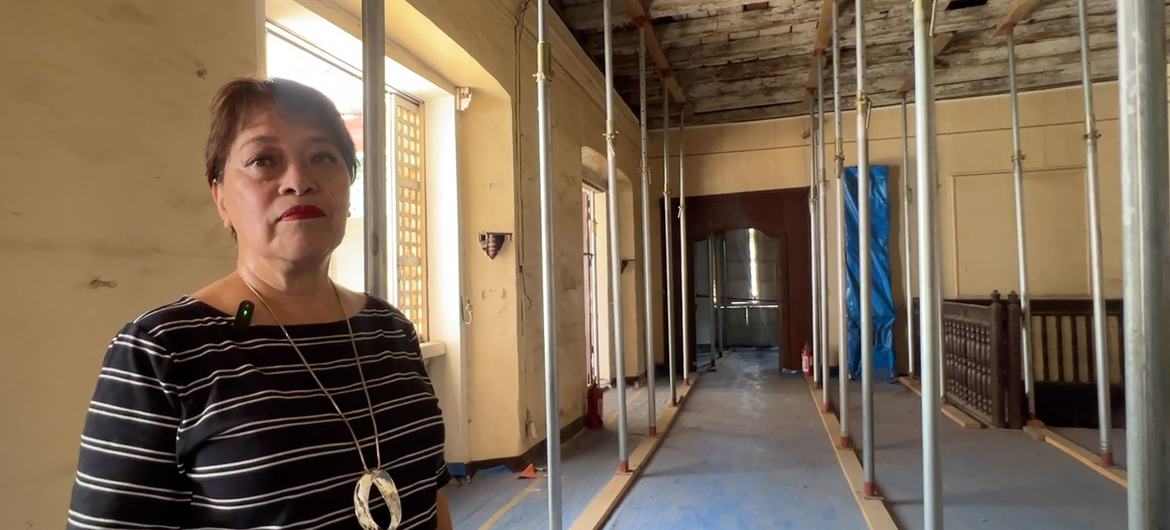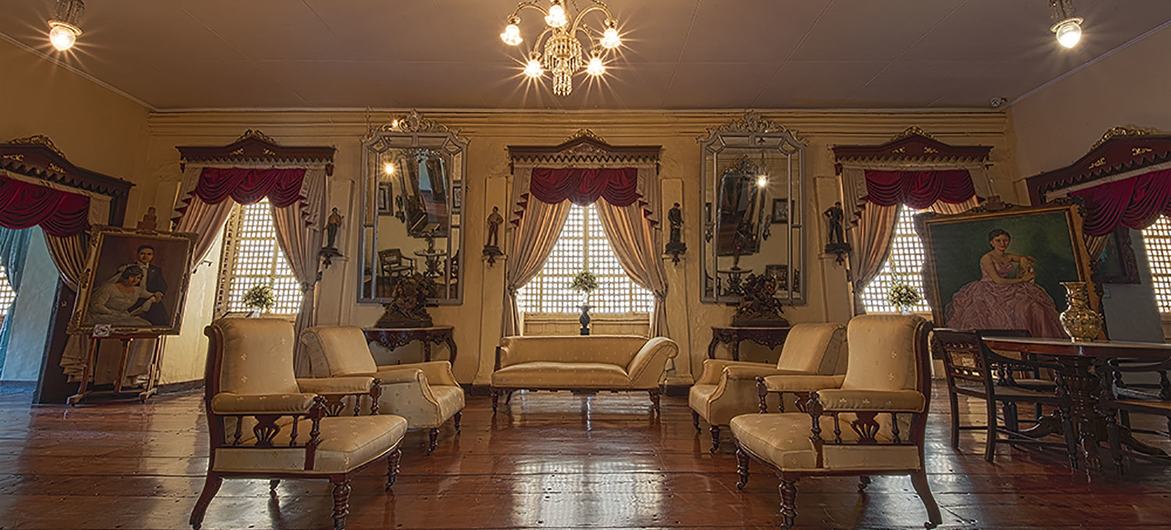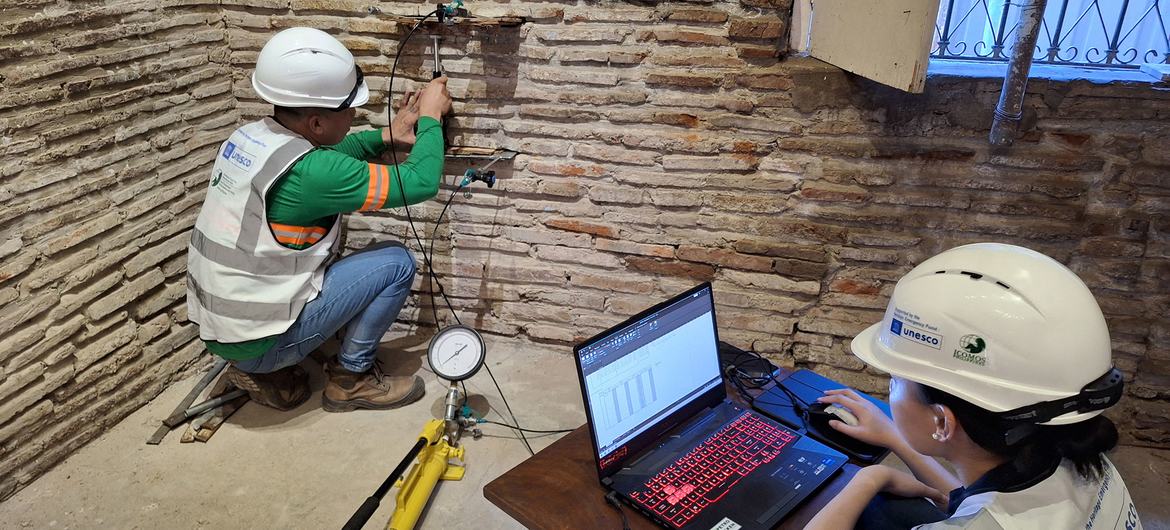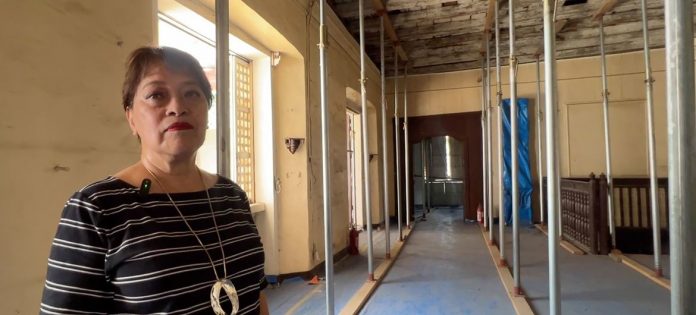In July 2022, a magnitude-7.0 earthquake shook the northwestern Philippines, killing 11 people and injuring nearly 600 others. The quake and its aftershocks caused an estimated 1.6 billion pesos ($27.3 million) in damage to infrastructure and agriculture.
Among the hardest hit areas was the historic city of Vigan, a UNESCO World Heritage Site and one of the best-preserved Spanish colonial towns in Asia. About 100 ancestral homes, as well as the city’s 19th century cathedral and bell tower, were severely damaged. Most of the homes are in private hands and securing funding for their repair has been beyond the means of most residents.
Lasting impacts of the quake
Homeowner Milagros “Mitos” Belofsky remembers well when she received a phone call about the impact of the earthquake on her family’s historic house, the Syquia Mansion—one of the largest Spanish-era homes in Vigan.
“I was in Manila and our staff called me right away to say that there was a strong earthquake,” she said, adding that she made the seven-hour drive from Manila to Vigan the very next day. “I saw the house in shambles, what had fallen, what had broken. It was overwhelming.”

Mitos Belofsky is overseeing repairs to in the her family’s ancestral home, Syquia Mansion.
Two years after the earthquake, the Syquia Mansion and many other Vigan heritage houses have yet to be restored to their former glory.
The families that serve as custodians of these historic homes said that aside from the high costs of repair and restoration, they are also facing challenges in rehabilitating the houses the right way, using appropriate techniques and materials to conserve structural integrity and authenticity.
UNESCO steps in
To help support the Vigan heritage community in post-disaster recovery, UNESCO and the International Council on Monuments and Sites (ICOMOS) in the Philippines mobilized a multi-disciplinary team of experts for detailed assessments of several damaged houses and capacity building workshops for homeowners and local craftsmen.
The yearlong project was implemented through UNESCO’s Heritage Emergency Fund (HEF), a multi-donor fund for the protection of cultural heritage in emergencies. The initiative is the first to be funded by the HEF in the Philippines.
Moe Chiba, Head of the Culture Unit at UNESCO’s regional office in Jakarta, said the HEF Vigan project is meant to supplement efforts to rehabilitate the city’s ancestral homes, as the bulk of the Philippine government’s funding for post-earthquake recovery was channeled towards the restoration of the cathedral and bell tower, which are publicly owned monuments.

The sala or living room of the Syquia Mansion.
“[There was] very limited funding to support the owners of privately owned houses. But the uniqueness of this city [is the] traditional houses which are a perfect example of the blend of Spanish colonial and Chinese trading history,” she said.
The HEF-Vigan project was allocated a budget of over $105,000 and was launched in October 2023.
Preserving craftsmanship and techniques
Over the course of one year, UNESCO, ICOMOS Philippines and local partners completed the screening of 30 priority ancestral houses—two of which were ultimately chosen to be the project’s main “sample” houses which underwent full structural assessments.
A team of 40 architects, engineers and other technical experts examined the Syquia Mansion and Cabildo House to document the extent of damage and develop recommendations for the proper repair and restoration of the structures.
“The utmost challenge was making people realize that documentation is probably the most essential part of restoring historic structures. If you don’t do documentation along the way, if you proceed directly to the restoration, there’s a possibility that you will obliterate the attributes that are significant to that heritage structure,” said ICOMOS Philippines Chairman and President Cheek Fadriquela.
Blueprint for restoration
Findings of the assessments formed the basis for a master plan to rehabilitate the Syquia Mansion and the Cabildo House. These were also translated into the building blocks of a capacity building programme for over 80 of Vigan’s homeowners and craftsmen, including masons and carpenters.
The series of workshops and hands-on training activities were conducted to provide the city’s residents with the technical knowledge needed for proper maintenance and upkeep of heritage houses, including information on woodwork, plastering, painting and the sourcing of appropriate materials for repairs.
According to Emmeline Versoza, homeowner and custodian of the Villa Angela ancestral house and a participant in the workshops offered through the HEF-Vigan project, such capacity building activities should continuously be provided to homeowners and those who work in heritage house restoration.

Technicians assess the structure of an historic building in Vigan.
“If we say that we are a heritage city, the architects, engineers and contractors should really have the expertise,” she said.
The HEF-Vigan project will share the lessons learned from the assessments of the Syquia Mansion and Cabildo House through publications outlining best practices in heritage conservation in Vigan.
Most notable of these is guidance to help the city mitigate hazards and better prepare for any future natural hazards.
The project’s recommendations will also be used to update and revise the Vigan Heritage Homeowner’s Preservation Manual, which was originally published by UNESCO in 2010.
Looking ahead and building resilience
Efforts are underway to include heritage conservation in disaster risk reduction and management plans following the grave impacts of the 2022 earthquake and 2023 flooding on the city since both the local government and residents are determined to help Vigan weather any future storms.
“The identity of Vigan is not the same without these historic ancestral houses and structures,” said Vigan City Architect Christian Nico Pilotin, adding, “They are important to Vigan because [the city] used heritage conservation as a tool for development.”

